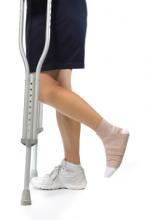
Most common sport-related musculoskelatal injuries, such as a sprained ankle, or moderate to severe ligament or muscle strain, can be treated by your child's primary care physician, who can help you decide if a referral to a sports medicine specialist, such as an orthopedist, is required, or by the team's athletic trainer.
But, regardless of severity, recovery is a six-step process:
- Immediate first aid (e.g. PRICE) to limit discomfort, reduce healing time, minimize swelling, and help the physician establish an accurate diagnosis
- Allow healing. While your child is bruised and sore, and perhaps on crutches or in a cast or splint, he probably will not be tempted to begin exercising the part of his body that is still hurting. If he insists on exercising to stay in shape while the injury heals, make sure he checks with the athletic trainer or his doctor first to make sure it is an activity, like swimming, that doesn't put stress on the injured area. Sometimes the doctor really wants a kid to do nothing. And even if she approves the exercise, she may want the child to work with a trainer to rehab the non-injured body correctly. This is also a time when you will want to make sure your child eats right
- Rehabilitation. After pain and swelling subsides to minimal levels, it is time to begin exercises that the athlete's doctor, athletic trainer, or physical therapist has prescribed to regain range of motion (if he does not, he may never get the range of motion back!), balance, normal gait (after a leg injury) and strength (muscle strength doesn't come back on its own). If the injury becomes chronic and progress seems to stop and pain remains, following up with a sports medicine physician for further evaluation is recommended. Using ankles as example, if your child can move the injured ankle in the same way and as far as his good ankle, he is ready to move on to the next step in the recovery process. A rule to follow: no return to sports if there is any limited motion in a joint. When your child appears to you to be walking and jogging normally, he is ready for the next step in coming back from her injury. No child should be allowed to return to sports if he is still limping.
- Regain endurance. Fortunately, most healthy athletes, especially kids, regain their endurance pretty quickly, but your child won't be really ready to play again until he does. It's important that, in building endurance, your child doesn't stress his system. He should activities like swimming, running in the water, biking or rowing. Working out three times a week for 30 minutes each time should be enough.
- Regain skills. If your child has been away from her sport for any length of time, his skills (whether it be dribbling and shooting a basketball, hitting a softball, or kicking a soccer ball) won't be as sharp as they were before the injury. He should work in regaining her skills before playing in competition.
- Regain confidence. When a child suffers an injury that keeps him out of sports for an extended period of time, he suffers a psychological loss as well as physical injury. It is therefore important for him to not only be physically ready to return to sports but psychologically ready as well. If he returns too soon, he risks re-injury, injury to a different part of the body, depression, and/or decreased performance.
Because kids are usually eager to return to play and don't have the discipline to take these steps on their own, and because parents don't have the experience to know when it is safe for their child to progress to the next step, consulting with an athletic trainer (AT) and/or physical therapist at each step along the way is advised. All take time, patience and your encouragement. Skip any of these six steps, or do them out of order, and your child will risk re-injury and his road to complete recovery will probably be longer.



